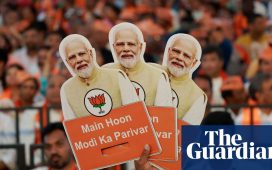The court’s verdict comes against the backdrop of a heightened assertion of Hindu nationalism by the government of India’s prime minister, Narendra Modi, which was elected for a second term with an overwhelming majority in May.
Shortly after, in August, Mr. Modi abrogated the autonomy of Muslim-majority Kashmir. The decision was in keeping with the long-stated demands of the Rashtriya Swayamsevak Sangh, the Hindu nationalist mother ship whose influence over Indian society today can be compared to the sway of the Communist Party in China.
The R.S.S. is set to celebrate its hundredth year in 2025, and the temple that is likely to be built in time is an appropriate marker of its rise from insignificance. A few years back, I traveled to Ayodhya. Since the demolition of the Babri mosque, a workshop run by an R.S.S. affiliate has been preparing for Rama’s temple. A model of the temple stands at the heart of the workshop. At one end of the workshop, rows of bricks marked “Shri Ram,” which were brought there by pilgrims from across the country, were piled up.
The ground where the mosque once stood was guarded by armed policemen. I walked with a crowd of Hindu pilgrims through a corridor covered with wire meshing. Several body searches later, we stopped in front of a makeshift temple to Rama, where a policeman played the part of a priest. The pilgrims were curious to know where the mosque had stood, but there was nothing to indicate that it had ever existed. The erasure had been complete.
Back at the temple workshop, I saw a wooden model for Rama’s temple, as envisioned by the R.S.S.: a two-storied structure, 268 feet 5 inches long, 140 feet wide and 128 feet high, with 106 pillars on each floor and 16 statues carved on each pillar. Behind me, the visitors raised slogans to Rama.
In the early years of Indian Independence, Jawaharlal Nehru, the first prime minister of India, spoke of steel factories and dams as the temples of modern India that would propel the country toward prosperity. Speaking after the court’s verdict, Mr. Modi said: “The Supreme Court verdict has brought a new dawn. Now the next generation will build a new India.” But this temple, the symbol of Mr. Modi’s India, is being born out of acts of criminality, embodying the Hindu nationalist vision of the subordination of others.
On a recent visit to the northern Indian state of Punjab, I spoke to friends and family — all from the Sikh minority — and I realized that something fundamental had changed. The Sikhs are not a minority threatened by the B.J.P., which claims them as their own, a part of the Hindu fold, but their clear sense of a distinct identity has left them deeply uncomfortable with the vision of a Hindu nation.




